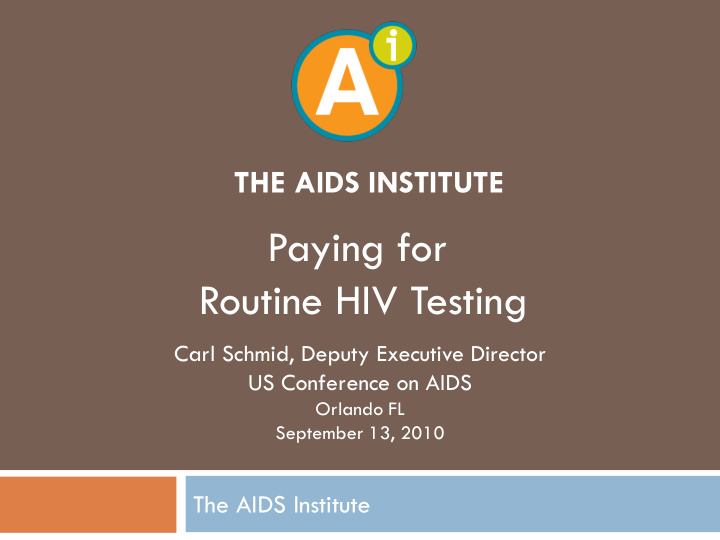



THE AIDS INSTITUTE Paying for Routine HIV Testing Carl Schmid, Deputy Executive Director US Conference on AIDS Orlando FL September 13, 2010 The AIDS Institute
Why Reimbursement is Important • Estimated 21 percent, or 231,000 people who are living with HIV do not know it • CDC recommended routine HIV testing in 2006 • Reimbursement has been a barrier to implementation The AIDS Institute
Presentation Outline • Examine the Current State of Reimbursement & Opportunities for the Future • Health Care Reform • National HIV/AIDS Strategy The AIDS Institute
Payers of HIV Testing • CDC Appropriated Dollars • Private Insurance • Medicaid • Medicare The AIDS Institute
US Preventive Services Task Force • Sponsored by Agency for Healthcare Research and Quality (AHRQ) • Leading independent panel of private-sector experts in prevention and primary care • Conducts rigorous, impartial assessments of scientific evidence for effectiveness of clinical preventive services, including screening, counseling, and preventive medications The AIDS Institute
US Preventive Services Task Force • Recommendations are considered the "gold standard“ for clinical preventive services • Key to coverage determinations, particularly in health reform implementation The AIDS Institute
July 2005 Review • Strongly recommends that clinicians screen for HIV in all adolescents and adults at increased risk for HIV infection. • Grade A Recommendation The AIDS Institute
July 2005 Review • Recommends that clinicians screen all pregnant women for HIV • Grade A Recommendation The AIDS Institute
July 2005 Review • No recommendation for or against routinely screening for HIV adolescents and adults who are not at increased risk for HIV infection • Grade C Recommendation • Reconfirmed in 2007 The AIDS Institute
Clinical Considerations A person is considered at increased risk for HIV infection (and thus should be offered HIV testing) if he or she reports 1 or more individual risk factors or receives health care in a high-prevalence or high-risk clinical setting The AIDS Institute
Persons at higher risk for HIV infection • Those seeking treatment for STDs; • Women and men whose past or present sex partners were HIV-infected, bisexual individuals, or injection drug users; • Men who have had sex with men; • Persons with a history of transfusion • Past or present injection drug users; between 1978 and 1985; • Persons who exchange sex for money or • Persons who themselves or whose sex drugs, and their sex partners; partners have had more than one sex partner since their most recent HIV test. • Persons who request a test; • The AIDS Institute
High Risk Settings • High-risk settings include STD clinics, correctional facilities, homeless shelters, tuberculosis clinics, clinics serving men who have sex with men, and adolescent health clinics with a high prevalence of STDs • High-prevalence settings are defined by the CDC as those known to have a 1% or greater prevalence of infection The AIDS Institute
2007 Focused Evidence Update by USPSTF • Found insufficient evidence to change the main conclusions of our 2005 evidence synthesis. • Specifically, the 2005 evidence synthesis found no direct evidence on the effects of HIV screening on clinical outcomes. • There remains no direct evidence on benefits of screening for HIV infection in the general population The AIDS Institute
Time for Another Review? • Many new studies since 2007 • Cost effectiveness of routine testing in lower prevalence areas • Clinical benefits improved, treatment recommendations changed • New studies on reduced transmission when treatment begins • New perceptions on the absence of harm of routine testing • Begin process to review in late 2010 The AIDS Institute
Health Reform • Includes Prevention, not just care and treatment • Coverage for Preventive Services • Primarily for Grade A & B Services • Should be able to Greatly Expand HIV Testing • But not routine testing The AIDS Institute
National HIV/AIDS Strategy • Acknowledges High Number of Undiagnosed, prevention benefits of knowing status, and late diagnoses • Goal: by 2015, increase from 79 percent to 90 percent the percentage of people living with HIV who know their serostatus (from 948,000 to 1,080,000) The AIDS Institute
National HIV/AIDS Strategy • Lack of detail on how that will be achieved • Mention of CDC Routine Testing Recommendations • Major focus on targeting resources on populations and areas most affected by HIV • Agency Implementation Plans Due December 2010 The AIDS Institute
National HIV/AIDS Strategy • Cross Agency collaboration and coordination key • HIV Reimbursement Workgroup will offer suggestions • CDC officials have stated in order to achieve goals, must implement routine HIV testing • Paying for those tests will be critical The AIDS Institute
THE AIDS INSTITUTE THANK YOU Carl Schmid - cschmid@theaidsinstitute.org 202-462-3042 www.theaidsinstitute.org/USCA2010 The AIDS Institute
Recommend
More recommend